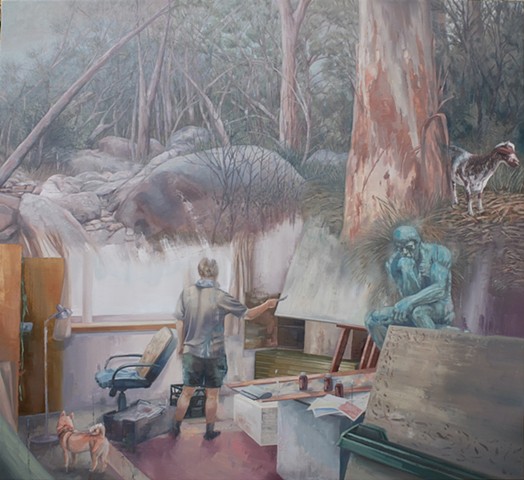2020 'It is Not Down in Any Map; True Places Never Are'
Private Collection, exhibited at the 2020 Busselton Art Awards, WA.
Cabin explores the relationship between painting and what it offers to the wider artistic discourse.
One of the recent focuses of my practice has been exploring how we are engaging with the natural environment. Cabin is a self-portrait depicting the artist in the studio, which is consuming and also being consumed by the wilderness. Cabin encourages the questioning of the conceptual function of painting, and what artistic practice can offer to the conversation of environmental conversation.
By representing the artist in the studio Cabin refers to not only work, but coupled with the blank canvasses presents endless opportunity, and conversely the unfortunate bouts of creative blocks that come with working in the creative industries.
The painting features snippets of photographs taken in Tasmania, mainly the Freycinet National Park and Wineglass Bay, and the suburban streets of Launceston. Tasmania represents an ancient, pristine wilderness to most city-dwelling Australians, and in Cabin serves to remind us of the shrinking hectares of natural landscape the world over, and humans’ direct environmental impact on this. Conversely, these photographs are also a tribute to my love of travel, and symbolises escapism and new adventures.
Cabin also features a goat, and a dog, both used to indicate species hierarchy, and the domestication of wild animals. Species hierarchy is an ongoing focus of my work, and this iteration aims to call into question the animals humans deem worthy of domestication, and for what reasons.
The work features Auguste Rodin’s sculpture The Thinker (1904) staring into the situation unfolding, and pondering how our understanding of being human affects our ability to prosper and continue as a species.
Cabin is the continuation of the series of self-portraits in the studio, alongside Paranoia (2019). An excerpt from Professor Ted Snell’s essay on the work examines the themes explored: “The history of painting in Australia has served many nationalistic purposes, none more so that the Impressionism of Tom Roberts and Arthur Streeton and the mythologising of Sidney Nolan, but Martyn questions whether these artists have impacted on our behaviour? As Australia burns and vast tracks of land are turned to ash, devastating lives and destroying ecosystems, what role can art play?”
